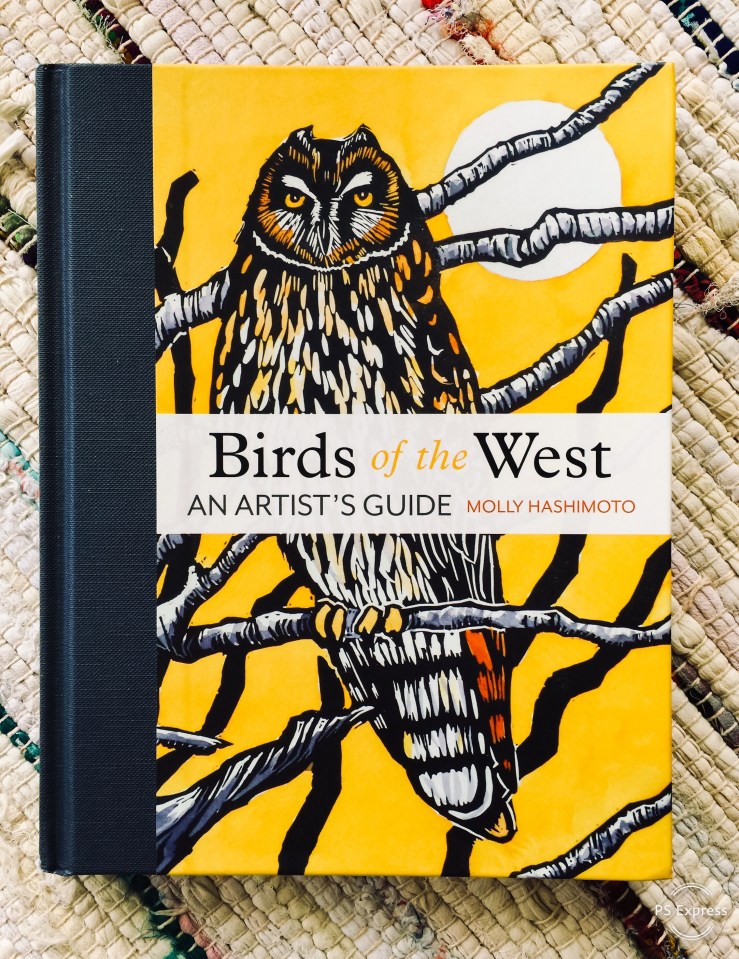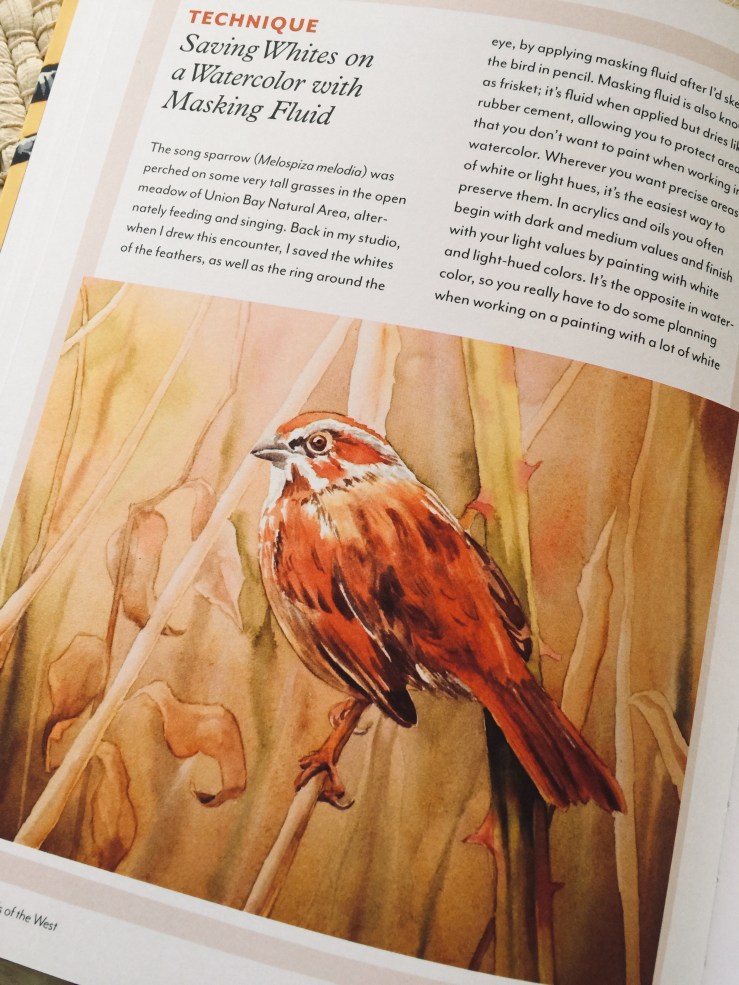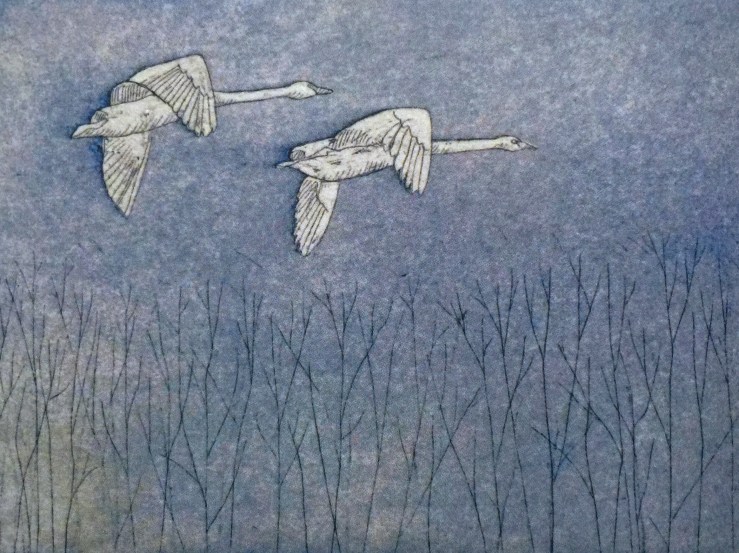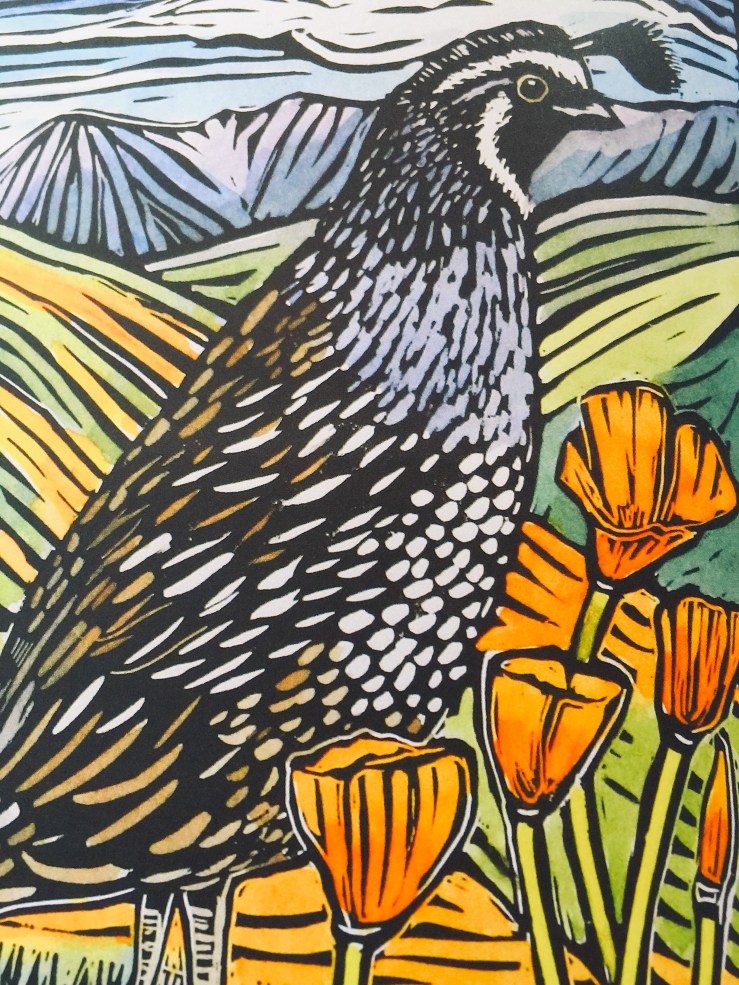
Short-eared owl, block print by Molly Hashimoto
“….there’s nothing quite as inspiring as a bird in its habitat – the ecosystem and the bird belong together in a coherent and necessary way.” Birds of the West: An Artist’s Guide, by Molly Hashimoto
This summer I was thrilled to find on my doorstep the exquisite Birds of the West: An Artist’s Guide by Molly Hashimoto, sent to me by her publisher Skipstone, the sustainable lifestyle imprint of Mountaineers Books.

I became a fan of Molly’s when I discovered her Colors of the West: An Artist’s Guide to Nature’s Palette in one of the national park bookstores my husband and I visited on our trip West two years ago. Molly is accomplished in watercolor, block printing, etching and egg tempera – the media she features in Birds of the West – informed by decades spent exploring the landscapes, flora, and fauna of the West. Her art combines a naturalist’s expertise with a deep love of nature.
Molly is a dedicated art teacher as well, based in Seattle. I’m sorry I missed her last year at Roundabout Books in Bend when she spoke and demonstrated techniques from Colors of the West. She teaches regularly in her local community and at the Sitka Center for Art and Ecology, the North Cascades Institute, the Wenatchee River Institute, and the Yellowstone Forever Institute.
Her love of teaching and her passion for birds shine through in this luminous new collection of nearly 100 bird species and more than 130 sketches, aimed for seasoned artists, beginner artists, and non-artists alike.

Exploring Molly’s new book was a bittersweet delight because, as I did so, the journal Science published a study revealing that one third of the birds in North America have died since I was in high school in the 1970s. A “staggering decline,” the authors of this study wrote.
Perhaps this sad development only affirms that the good work of Molly Hashimoto and other fine artists, writers, and humanists is more necessary than ever. We can hope that their love of art and nature will continue to be contagious – and more of us will be moved to observe birds and other wildlife with love and attention and become activists for and caretakers of the earth.

Molly writes eloquently, honestly, and tenderly – her background as an English literature major shows – in Birds of the West about the ethic of stewardship she seeks to inspire in the world:
“I don’t belong to the art for art’s sake camp. I want to make art about birds that is accurate about the ecosystem and true to the bird’s anatomy, characteristic gestures, and plumage colors. … I want my art to be in the service of the living, existing bird. That’s not to say that mere representation is all I aim for – photorealism can drain the life out of a subject. There’s a place somewhere between the representational and the conceptual that expresses all the meaning that I’ve found in watching birds. I also make art for the sake of connection and to inspire an ethic of stewardship.”

You don’t have to be an artist (I’m not) or a birder (I’m not) to fall in love with this fine collection. Molly shares inspiring nature poetry, quotes that capture the wisdom of famous artists and nature writers, and her own thoughts about great artists who have influenced her work. Here is one example:
“Georgia O’Keeffe believed that we want to make art of things that have moved us deeply, even if we don’t know exactly why or understand the meaning of what we feel. It is only by recording it, writing about it, or making art about it that it becomes clearer to us what it all means and why it is so important to us. I have found this many times, with every medium.”

In fact, you don’t even have to live in the West to benefit from Birds of the West. I can imagine artists and nature lovers and birders in other parts of the country using this as a model for exploring and rendering birds in their own regions.
Since I’m a writer, not an artist, I found myself looking at Birds of the West through my own idiosyncratic lens. Molly’s beautiful text taught me specific ways to observe birds in my own wanderings, and modeled how I might capture what I see on the page, via the written word. I don’t know if this was Molly’s intention, but like all good works of art, I think that her book is larger and more resonant than its creator originally intended.

I love Molly’s thoughts about how she chooses particular media to depict particular birds; I imagine that working artists especially will appreciate her insights:
“Every medium has a way of revealing distinct aspects of the birds. Etching utilizes fine lines that can precisely describe the elegant contours and feather groups of birds; watercolor, with its wide-ranging hues and many technical options of indicating trees, shrubs, grasses, rocks and all the components of an ecosystem, displays the manner in which they live and make use of their habitats. Sketches in pencil or pen, with and without added watercolor, convey, through their gestural quality, the attitude, demeanor, and movement of birds. Egg tempera, a centuries-old medium used in icons and altarpieces, can express the reverence I feel for birds and other animals. Relief or block prints, with their dramatic values, contrasts, and bright colors, help me share the surprise – sometimes even the shock – of encountering a new species. As composers work with many different types of instrumentation, with widely varying timbres and colors, such as full orchestras, smaller string groups, or choral ensembles, I use different media to express a range of moods and ideas.”

Molly includes a For Further Reading section that is especially rich, with field guides and books about natural history, ornithology, birds in art, and art techniques.
She has a helpful resources list too, with stores, supplies, and Pacific Northwest printmaking co-ops and studios that offer classes, workshops and press time.

I hope someday I have the opportunity to attend one of Molly Hashimoto’s art workshops or book signings. I’d love to meet her, wouldn’t you? The next best thing would be to get your hands on the lovingly created Birds of the West: An Artist’s Guide.




“The silence of the desert, the sound of wind through the high branches in a coniferous forest, the complex patterns of reflected color in ripples on a pond, the crashing surf, the austere beauty of alpine heights – all of these contribute to the great pleasure that comes with watching birds. In these locales and moments, we are sharing an environment with the birds, which gives us, earthbound as we are, a deeper connection with our fellow creatures.” – Molly Hashimoto
Birds of the West: An Artist’s Guide, by Molly Hashimoto

What a beautiful book. You might like this book, too: https://hopewellslibraryoflife.wordpress.com/2021/02/01/review-the-first-of-two-books-with-the-same-title-wintering-stephen-rutts-wintering-a-season-with-geese/
This does look good – and I’m wondering if the other book is by Katherine May – I’ve been waiting for her book from the library.
On Wed, 10 Feb 2021 at 14:22, Books Can Save A Life wrote:
>
It is! The review is up!
Bellissimo!
Thanks Judy!
Ravishing book and blog and glorious illustrations.
I think it is possible to counter the decline in wild life. Since we began a concerted programme of pest control in our forest, not only bird life has leapt in numbers but also insect life which had also been declining, while a species of frog which was number one of the worldwide list of endangered species has now been upgraded, thanks just to our conservation programme here..
Valerie, that’s so encouraging. Thank you for stopping by, reading, and giving us these words and facts that demonstrate there is hope if we take action
This is a very beautiful book and not one that I would have never come across given that like you, I am neither an artist or a bird-watcher.
The quote from Georgia O’Keeffe, a much more poetic version of the adage about writing so that you know what you think, really resonated with me. I love the idea that by making art, we are also working out why things matter to us, so thank you for sharing your thoughts and this lovely book.
Thanks Margaret. The Okeeffe quote is one of my favorites.
What a stunningly gorgeous book! I like how she includes information about her technique too.
I was so brokenhearted over that Science report when it came out. I have definitely noticed not only fewer birds but fewer varieties of birds around my neighborhood through the years. I’ve been deluding myself that they have just been going elsewhere. Makes me extra appreciative of the birds that are still here, especially the tiny ones that flock to my garden and the big bald eagles I see now and then.
Hi, Stefanie, thanks for visiting and commenting. I’m wondering if the huge drop off in birds is because there are so many outdoor cats – I comfort myself that perhaps that might be some of the cause, which I think could be addressed, rather than some horrible collapse of the overall environment. The bird news depressed me more than any awful Trump news I heard that week. Glad of kindred souls like you who are in the fight to save the earth.
I suspect cats might have a role, but I also fear that it is due to climate change, habitat loss, and pesticides. The insect population is plummeting as are fish populations which does not bode well for our feathered friends of us!
I agree, it is good to know there are kindred souls out there. I am not sure how I would make it through most days if not for that!
Amazing illustrations.
Thanks Judy. I think this one is right up your alley! I wonder if it is in your local library yet?
I checked, but they don’t have it ‘yet.’